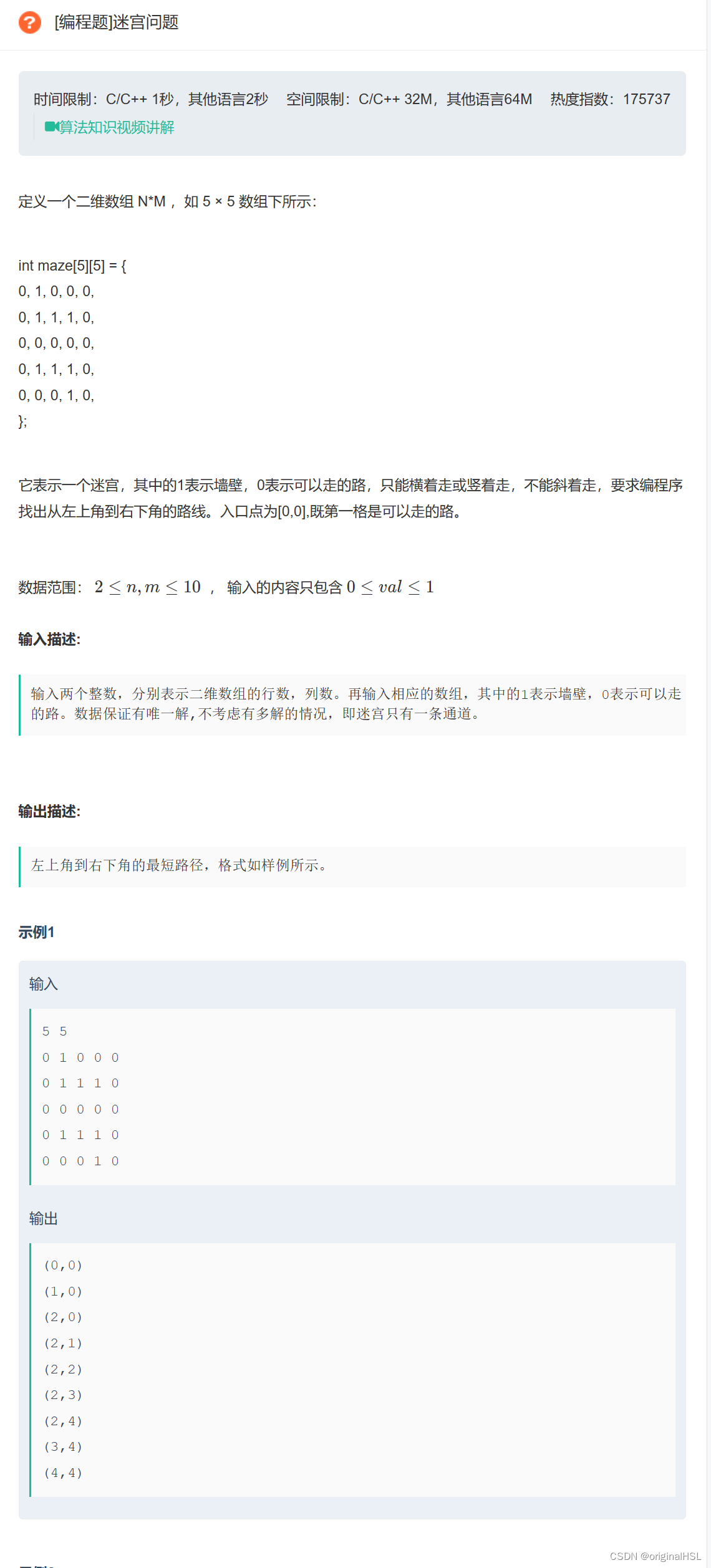迷宫问题是一种基础的算法问题,需要通过编程实现在一个迷宫中找到从起点到终点的路线。通常使用深度优先搜索或广度优先搜索算法来解决这个问题(主要是使用递归回溯和栈)

具体步骤如下:
1.定义一个二维数组表示迷宫,其中 0 表示可以通过的路,1 表示障碍物。
2.定义起点和终点坐标。
3.使用深度优先搜索或广度优先搜索算法在迷宫中搜索路径,记录经过的路径。
4.如果搜索到终点,则返回路径,否则返回无解。
代码及注释如下
#include <stdio.h>
#include <stdlib.h>
#include <stdbool.h>
#include <assert.h>
//迷宫问题
//用结构体存迷宫的坐标
typedef struct Maze
{
int row;
int col;
}PT;
//由于C语言没有栈的库,所以用‘-’分隔一下栈相关的代码
//-------------------------------------------------------------------
typedef PT Type;//Tpye表示的是PT结构体类型
typedef struct Stack
{
Type* a;
int top;//栈顶
int capacity;//容积
}ST;
void StackInit(ST* ps);
void StackDestory(ST* ps);
//栈顶插入删除数据
//入栈
void StackPush(ST* ps, Type x);
//出栈
void StackPop(ST* ps);
Type StackTop(ST* ps);
int StackSize(ST* ps);
bool StackEmpty(ST* ps);
//初始化
void StackInit(ST* ps)
{
assert(ps);
ps->a = (Type*)malloc(sizeof(Type) * 4);
if (ps->a == NULL)
{
printf("扩容失败\n");
exit(-1);
}
ps->capacity = 4;
ps->top = 0;
}
//销毁
void StackDestory(ST* ps)
{
assert(ps);
free(ps->a);
ps->a = NULL;
ps->top = ps->capacity = 0;
}
//栈顶插入删除数据
//入栈(插入)
void StackPush(ST* ps, Type x)
{
assert(ps);
//满了就增容
if (ps->top == ps->capacity)
{
Type* tmp = realloc(ps->a, ps->capacity * 2 * sizeof(Type));
if (tmp == NULL)
{
printf("扩容失败\n");
exit(-1);
}
else
{
ps->a = tmp;
ps->capacity *= 2;
}
}
ps->a[ps->top] = x;
ps->top++;
}
//出栈(删除)
void StackPop(ST* ps)
{
assert(ps);
//栈空了,直接终止
assert(ps->top > 0);
ps->top--;
}
//
Type StackTop(ST* ps)
{
assert(ps);
assert(ps->top > 0);
return ps->a[ps->top - 1];
}
//求数据个数
int StackSize(ST* ps)
{
assert(ps);
return ps->top;
}
//
bool StackEmpty(ST* ps)
{
assert(ps);
return ps->top == 0;
}
ST path;//定义一个全局的栈,用来存放迷宫路径位置的坐标
//----------------------------------------------------------------------------
//输出坐标
//(由于我们把坐标存入栈时的顺序和题目要求的顺序一样,就会导致出栈时坐标是反着出的
//,因此就需要倒置栈中的元素)【具体操作就看下面的PrintPath函数】
void PrintPath()//由于path是全局变量,就不需要再传参了
{
//将栈里元素入到另外一个栈里面
//再输出另外一个栈的元素,就实现了倒置
ST rpath;//用这个栈来输出
StackInit(&rpath);//初始化栈
while (!StackEmpty(&path))//把path中的元素入到rpath中来
{
StackPush(&rpath, StackTop(&path));
StackPop(&path);
}
while (!StackEmpty(&rpath))//再输出rpath中的元素,就就实现了倒置
{
PT top = StackTop(&rpath);
printf("(%d,%d)\n", top.row, top.col);
StackPop(&rpath);
}
StackDestory(&rpath);
}
//测试迷宫图是否正确(不写这个函数也行)
void PrintMaze(int** maze, int n, int m)
{
for (int i = 0; i < n; i++)
{
for (int j = 0; j < m; j++)
{
printf("%d ", maze[i][j]);
}
printf("\n");
}
}
//判断该位置是否能走
int IsPass(int** maze, int n, int m, PT cur)
{
//坐标不能越界且该位置值为0
if (cur.col >= 0 && cur.row >= 0
&& cur.col < m && cur.row < n
&& maze[cur.row][cur.col] == 0)
{
return 1;
}
else
{
return 0;
}
}
//判断迷宫是否能走到出口(递归回溯)
//(如果该位置能走通,就入栈,走不通(死路),就把该位置坐标弹出栈)
int MazePath(int** maze, int n, int m, PT cur)//cur表示从迷宫走的起始位置坐标
{
StackPush(&path, cur);//入栈
//如果走到出口
if (cur.row == n - 1 && cur.col == m - 1)
{
return 1;
}
//探测上下左右四个方向
PT next;//定义一个存放下一个位置坐标的结构变量
maze[cur.row][cur.col] = 2;//把走过的位置设为2,以防死递归
//上
next = cur;
next.row -= 1;
//如果下一个位置能走,就递归【上下左右同理】
if (IsPass(maze, n, m, next))
{
if (MazePath(maze, n, m, next))
return 1;
}
//下
next = cur;
next.row += 1;
if (IsPass(maze, n, m, next))
{
if (MazePath(maze, n, m, next))
return 1;
}
//左
next = cur;
next.col -= 1;
if (IsPass(maze, n, m, next))
{
if (MazePath(maze, n, m, next))
return 1;
}
//右
next = cur;
next.col += 1;
if (IsPass(maze, n, m, next))
{
if (MazePath(maze, n, m, next))
return 1;
}
//如果上下左右都不通,就把该位置坐标弹出栈
StackPop(&path);//出栈
return 0;
}
int main()
{
int N = 0;
int M = 0;
while (scanf("%d %d", &N, &M) != EOF)
{
//动态开辟二维数组
int** maze = (int**)malloc(sizeof(int*) * N);
for (int i = 0; i < N; i++)
{
maze[i] = (int*)malloc(sizeof(int) * M);
}
//输入
for (int i = 0; i < N; i++)
{
for (int j = 0; j < M; j++)
{
scanf("%d", &maze[i][j]);
}
}
StackInit(&path);
PT str = {
0,0 };
if (MazePath(maze, N, M, str))
{
//找到了
PrintPath();
}
else
{
printf("未找到");
}
StackDestory(&path);
for (int i = 0; i < N; i++)
{
free(maze[i]);
}
free(maze);
maze = NULL;
}
return 0;
}
运行结果:

迷宫问题的意义
迷宫问题是一类经典的寻路问题,通常被用来测试和研究搜索算法、路径规划算法和人工智能等方面的技术。在现实生活中,迷宫问题的应用场景非常广泛,例如在物流配送中的路径规划、机器人导航、游戏设计和智力竞赛等方面都有应用。此外,解决迷宫问题可以锻炼人的逻辑思维、学习算法的实现和优化、提高计算机编程能力等。